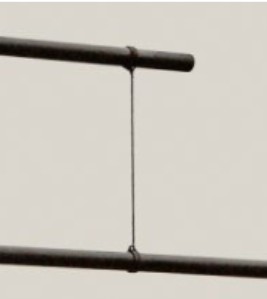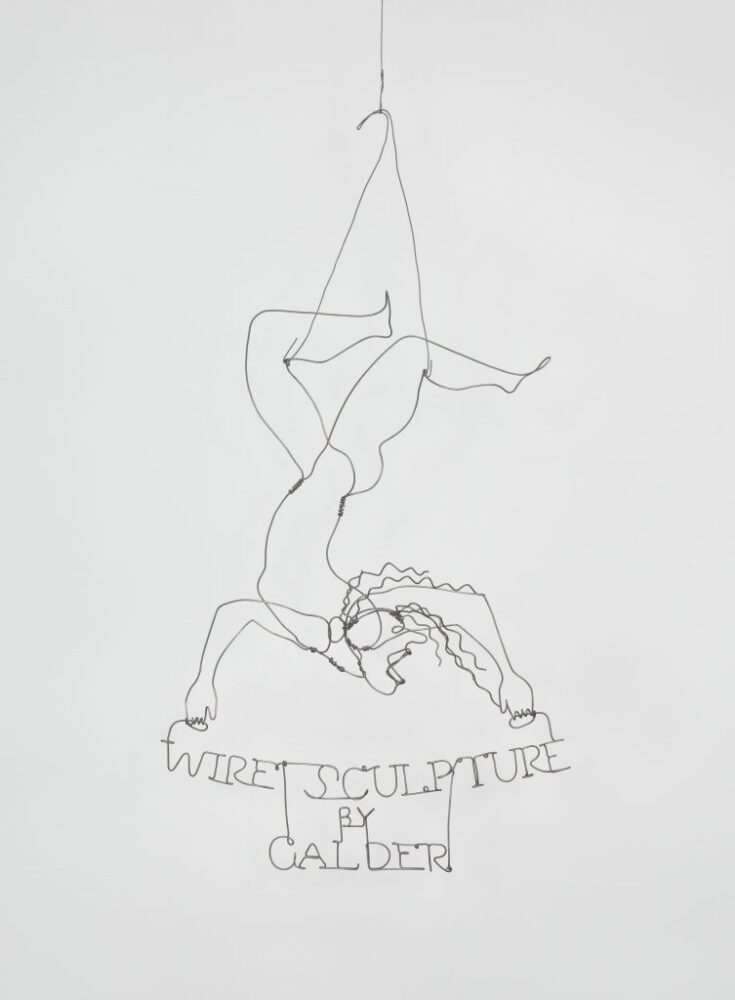As mentioned previously, for my final project I will be creating a Mobile in the Art Nouveau Aesthetic. My main inspiration for this project is the work of Alexander Calder, who pioneered the mobile as a form of kinetic sculpture.
Specifications:
1.) Balance and Equilibrium
The most essential specification to meet for my artifact will be balance. This aspect is critical to both the function of the mobile, and the art nouveau aesthetic. In regards to function, the mobile must be balanced physically. As seen in the cover image Peacock and below in Vertical Foliage, a key element to Calder’s Mobiles is their balance, a complex arrangement of bars and weights that will remain in their pattern when at rest. Aesthetically, compositional balance is key to the art nouveau aesthetic, one of the more prominent motifs that I am planning to employ is the whiplash aesthetic, which play with compositional balance to create movement within the piece.

2.) Aesthetic
Meeting the Art Nouveau aesthetic is critical to the success of this project. If I do not meet this aesthetic, I will not have successfully completed the project. In order to successfully create a mobile in the Art Nouveau aesthetic there are two main elements that I would like to focus on. The first is the “Whiplash Motif” “[this] decorative motif that has come to define much of Art Nouveau is the seemingly innocuous gesture of the whiplash. An ornamental S-curve that writhes and coils, the whiplash is a force of energy that drove the art world into a new Modern era. Derived from studies of the natural world, including deep-sea organisms and botanical gardens, it may seem nothing more than a flowing line, but the whiplash marked a break from the constraints of old-world traditional art forms and heralded the coming of modern design” (Victoria and Albert Museum). The second element is the prolific use of highly stylized floral motifs. I really enjoy how these motifs look and will be incorporating these elements into my mobile as weights. I especially like how the Tiffany lamp shown is able to create floral patterns using glass that I would like to replicate. The photo on the right is an excellent example of this theme done in metal, that I would like to try and replicate with bent wire in my Mobile.

3.) Rotation
As mentioned in the balance specification, for this mobile to be a successful, it must be able to rotated freely about it’s joints while still providing an equilibrium position. The equilibrium position will in a large way define the static composition of the piece, but as important to the kinetic sculpture, is it’s ability to move. To replicate Calder’s work, there will be joints where the members can rotate about one another. If these joints are able to spin totally free, then the sculpture will have no rest position. To achieve this blend of dynamic movement when perturbed and static composition at rest, the joints must have a rest point that they reach to create the static composition. I will be achieving this using fishing line, similar to some of Calder’s own work, as shown in the image below which is a joint from his piece Untitled, c. 1937. Similar to a swing set, this will allow for the joints to rotate and twist about each other, but will always return to the same rest position when undisturbed.

4.) Materials
In an effort to pay homage to Calder’s work, I will be constructing my piece as much as is feasible using metal wire. Calder was incredibly passionate in his use of wire, even using it to “doodle” he would always keep some on him. This is reflected strongly in all of his mobiles, and even more so in some of his other works. The work shown below Wire Sculpture by Calder is a wire sculpture, a form Calder used prolifically.
 5.) Opulence
5.) Opulence
Art Nouveau uses decoration profusely to create a sense of opulence, which I will need to replicate to meet the Art Nouveau Aesthetic. Shown below are some examples of opulent items that I will use as inspiration for creating the counterweights in my piece. I especially enjoy how these works use wire to


Constraints:
1.) Size
The size of this artifact will constrain me quite heavily. Calder was known for doing works on a monumental scale. His work ___ is shown below. I however do not have the ability to create something so large. I am planning on having the longest member of the sculpture measure about 6 feet in length, to keep everything reasonable. This will constrain what kinds of things I will be able to create, although I think in a positive way.
2.) Weight
Similar to size weight will be important, mainly relating to my ability to keep the sculpture balanced to achieve the specifications above. If the weight of my materials are not correct, the sculpture will not balance. As well, similar to the size constrain, anything too heavy will be difficult to move and work with.
3.) Cost
Money is certainly a factor for this project, and I would like to keep my personal budget below 200$. This should be a fairly simple constraint to meet, being that the bulk of the material will be wire, and I already own the required tools to create my piece.
4.) Skill
My own skill will constrain me on this project. Sticking to what I know will help me immensely, and this even part of the reason I chose the mobile as my inspiration. I have a good amount of experience with wire and tube bending from jobs I have had, so I knew that this would be something that I would be able to construct.
5.) Time
Finally, time will be one the larger constraints to this project, as we only have so long to create the artifact. That being said, by working diligently I believe I can minimize the impact this constraint will have on my overall project.
Sources:
Victoria and Albert Museum. “The Whiplash.” V&A, https://www.vam.ac.uk/articles/the-whiplash. Accessed 11 March 2025.
Images (in order of appearance):
[0] Peacock, Calder Foundation. “Archive.” Calder Foundation, https://calder.org/archive/all/works/. [1] Vertical Foliage, Calder Foundation. “Archive.” Calder Foundation, https://calder.org/archive/all/works/. [2] I, Sailko, CC BY-SA 3.0, https://commons.wikimedia.org/w/index.php?curid=11822242 [3] Untitled, c. 1937 Calder Foundation. “Archive.” Calder Foundation, https://calder.org/archive/all/works/. [4] Wire Sculpture by Calder Calder Foundation. “Archive.” Calder Foundation, https://calder.org/archive/all/works/. [4] By Sandra Fauconnier – Own work, Public Domain, https://commons.wikimedia.org/w/index.php?curid=75501159 [5] By dalbera from Paris, France – Vitrail du hall d’entrée (House for an art lover, Glasgow), CC BY 2.0, https://commons.wikimedia.org/w/index.php?curid=24672238